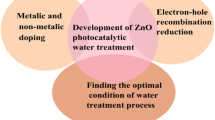Abstract
Sulfate radicals (SO4·−) are highly efficient for the degradation organic pollutants. SO4·− can be produced by activation of sulfites, yet actual heterogeneous activators exhibit a lower reactivity for activation of sulfite to SO4·− at pH 7.0–8.0. Here we hypothesized that zero-valent copper can activate sulfite under mild conditions. We tested the reaction with iohexol, diatrizoate, atrazine, benzoic acid, and p-chlorobenzoic acid contaminants. Reactive radicals were identified by electron paramagnetic resonance, fluorescence spectrometry, and radical scavenging experiments. Results show up to 90% abatement of contaminants by combining sulfite with zero-valent copper at pH 8.0. Moreover, zero-valent copper maintains a crystalline stability and satisfactory reusability with iohexol abatement efficiency up to 80% after five runs.



Similar content being viewed by others
References
Chen L, Tang M, Chen C, Chen M, Luo K, Xu J, Zhou D, Wu F (2017) Efficient bacterial inactivation by transition metal catalyzed auto-oxidation of sulfite. Environ Sci Technol 51:12663–12671. https://doi.org/10.1021/acs.est.7b03705
Chen L, Luo T, Yang S, Xu J, Liu Z, Wu F (2018) Efficient metoprolol degradation by heterogeneous copper ferrite/sulfite reaction. Environ Chem Lett 16:599–603. https://doi.org/10.1007/s10311-017-0696-1
Faungnawakij K, Tanaka Y, Shimoda N, Fukunaga T, Kikuchi R, Eguchi K (2007) Hydrogen production from dimethyl ether steam reforming over composite catalysts of copper ferrite spinel and alumina. Appl Catal B Environ 74:144–151. https://doi.org/10.1016/j.apcatb.2007.02.010
Graça CAL, Fugita LTN, de Velosa AC, Teixeira ACSC (2018) Amicarbazone degradation promoted by ZVI-activated persulfate: study of relevant variables for practical application. Environ Sci Pollut Res 25:5474–5483. https://doi.org/10.1007/s11356-017-0862-9
Guo Y, Lou X, Fang C, Xiao D, Wang Z, Liu J (2013) Novel photo-sulfite system: toward simultaneous transformations of inorganic and organic pollutants. Environ Sci Technol 47:11174–11181. https://doi.org/10.1021/es403199p
Hollanda LR, Graça CAL, Andrade LM, Mendes MA, Chiavone-Filho O, Teixeira ACSC (2019) Non-traditional atrazine degradation induced by zero-valent-copper: process optimization by the Doehlert experimental design, intermediates detection and toxicity assessment. J Chem Technol Biotechnol 94:1156–1164. https://doi.org/10.1002/jctb.5862
Jiang B, Liu Y, Zheng J, Tan M, Wang Z, Wu M (2015) Synergetic transformations of multiple pollutants driven by Cr(VI)-sulfite reactions. Environ Sci Technol 49:12363–12371. https://doi.org/10.1021/acs.est.5b03275
Moffett JW, Zika RG (1983) Oxidation kinetics of Cu(I) in seawater: implications for its existence in the marine environment. Mar Chem 13:239–251. https://doi.org/10.1016/0304-4203(83)90017-8
Mottley C, Mason RP (1988) Sulfate anion free radical formation by the peroxidation of (Bi)sulfite and its reaction with hydroxyl radical scavengers. Arch Biochem Biophys 267(2):681–689. https://doi.org/10.1016/0003-9861(88)90077-X
Neta P, Huie RE, Ross AB (1988) Rate constants for reactions of inorganic radicals in aqueous solution. J Phys Chem Ref Data 17:1027–1284. https://doi.org/10.1063/1.555808
Oh SY, Kang SG, Chiu PC (2010) Degradation of 2,4-dinitrotoluene by persulfate activated with zero-valent iron. Sci Total Environ 408(16):3464–3468. https://doi.org/10.1016/j.scitotenv.2010.04.032
Xie P, Guo Y, Chen Y, Chen Y, Wang Z, Shang R, Wang S, Ding J, Wan Y, Jiang W, Ma J (2017) Application of a novel advanced oxidation process using sulfite and zero-valent iron in treatment of organic pollutants. Chem Eng J 314:240–248. https://doi.org/10.1016/j.cej.2016.12.094
Zhang J, Ma J, Song H, Sun S, Zhang Z, Yang T (2018) Organic contaminants degradation from the S(IV) autoxidation process catalyzed by ferrous-manganous ions: a noticeable Mn(III) oxidation process. Water Res 133:227–235. https://doi.org/10.1016/j.watres.2018.01.039
Zhao X, Wu W, Yan Y (2019) Efficient abatement of an iodinated X-ray contrast media iohexol by Co(II) or Cu(II) activated sulfite autoxidation process. Environ Sci Pollut Res 26:24707–24719. https://doi.org/10.1007/s11356-019-05601-4
Zhou P, Zhang J, Liu J, Zhang Y, Liang J, Liu Y, Liu B, Zhang W (2016) Degradation of organic contaminants by activated persulfate using zero valent copper in acidic aqueous conditions. RSC Adv 6(101):99532–99539. https://doi.org/10.1039/C6RA24431A
Zhou D, Chen L, Li J, Wu F (2018a) Transition metal catalyzed sulfite auto-oxidation systems for oxidative decontamination in waters: a state-of-the-art minireview. Chem Engin J 346:726–738. https://doi.org/10.1016/j.cej.2018.04.016
Zhou P, Zhang J, Zhang Y, Zhang G, Li W, Wei C, Liang J, Liu Y, Shu S (2018b) Degradation of 2,4-dichlorophenol by activating persulfate and peroxomonosulfate using micron or nanoscale zero-valent copper. J Hazard Mater 344:1209–1219. https://doi.org/10.1016/j.jhazmat.2017.11.023
Acknowledgments
This work was funded by the National Natural Science Foundation of China (Grant No. 51808233).
Author information
Authors and Affiliations
Corresponding author
Additional information
Publisher's Note
Springer Nature remains neutral with regard to jurisdictional claims in published maps and institutional affiliations.
Rights and permissions
About this article
Cite this article
Zhao, X., Wu, Y., Xing, D. et al. Enhanced abatement of organic contaminants by zero-valent copper and sulfite. Environ Chem Lett 18, 237–241 (2020). https://doi.org/10.1007/s10311-019-00928-3
Received:
Accepted:
Published:
Issue Date:
DOI: https://doi.org/10.1007/s10311-019-00928-3




